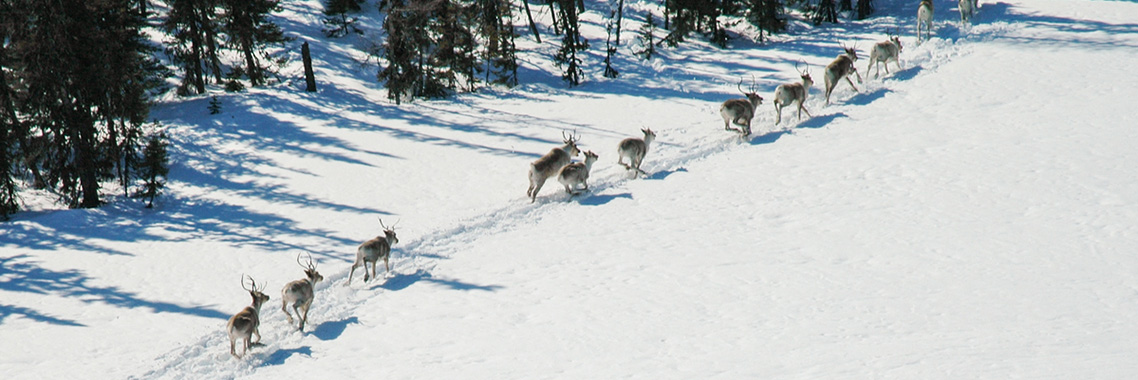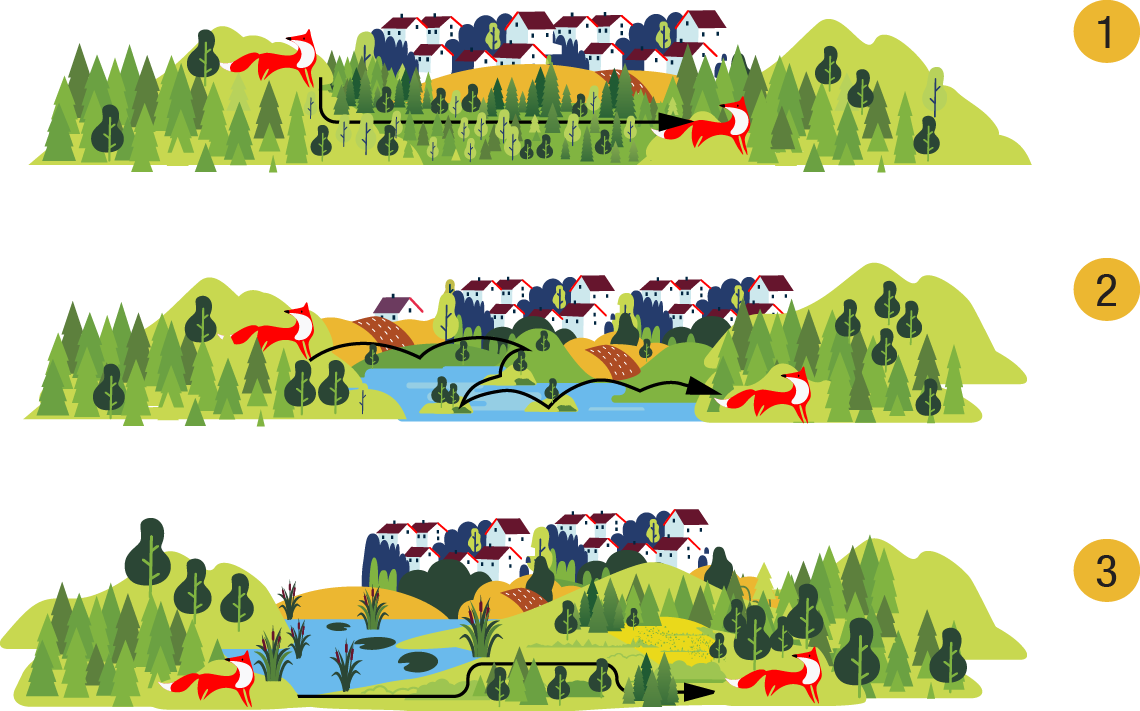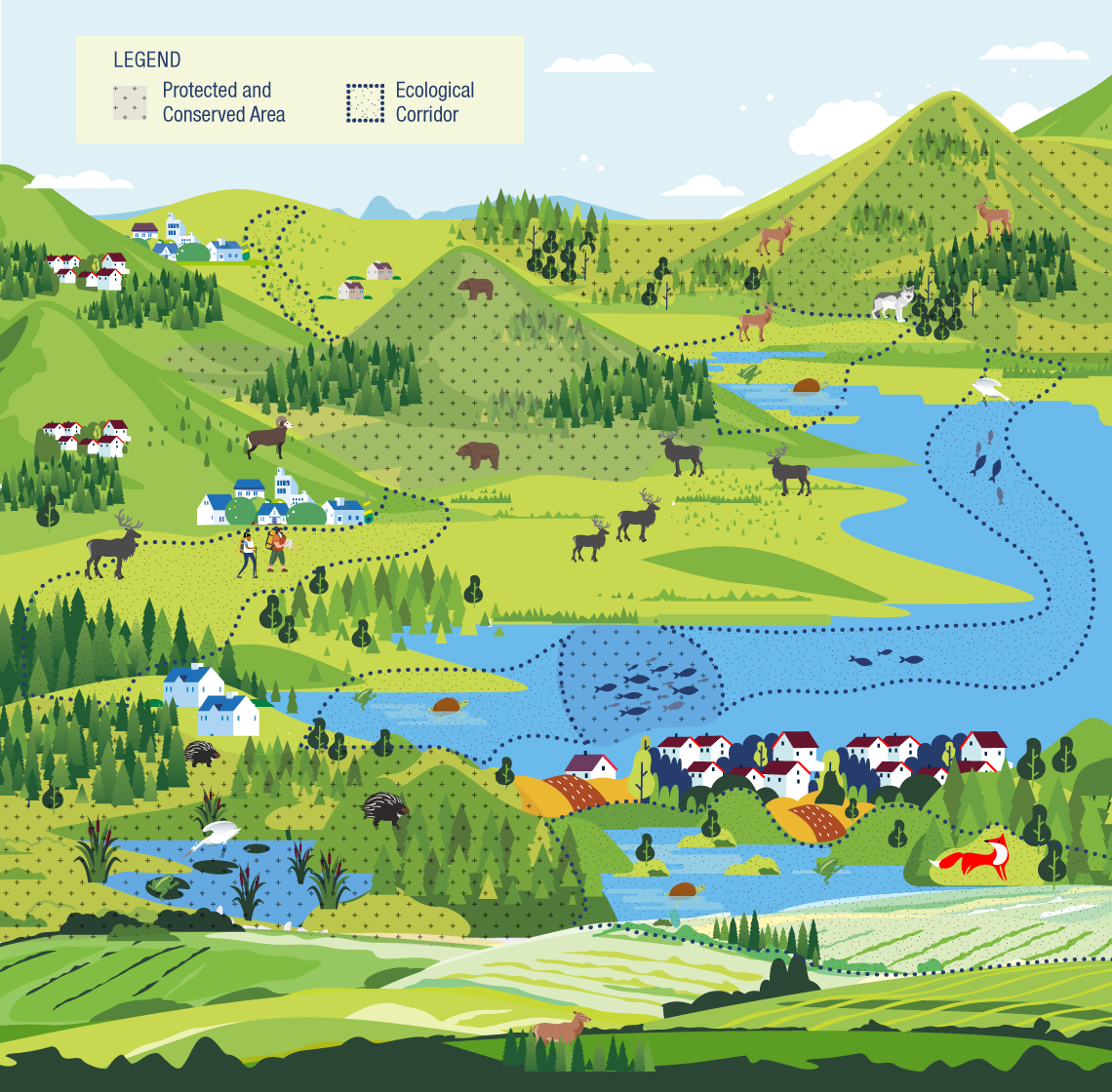
Ecological corridors
Conservation tools to complement protected and conserved areas
Ecological corridors help connect protected and conserved areas across large landscapes. They also:
- help species adapt to climate change
- lessen the impact of human development on natural habitats
- connect various habitat types needed for species' different life stages, including migration
- support vital ecosystem services like provision of food and clean air, as well as nutrient, and water cycles
- promote human-wildlife coexistence and ways for people to connect with nature
- complement protected and conserved areas by improving their ecological integrity

-
Three illustrations show the three main types of ecological corridors - Text version
The first represents linear corridors. Two forested hills are shown on the left and the right of a linear stretch of mixed-forest. A red fox is shown twice, standing on each forested hill. A black arrow moves from left to right, connecting both hills. It represents an ecological corridor and species movement. The forest is not fragmented in any way. A town with a road stretching towards it is shown behind the stretch of forest.
The second represents a stepping stone corridor. It also shows two forested hills on the left and right. This time, the mixed-forests are separated by a lake with small treed islands. A red fox is shown twice, standing on the forested hills on either side of the lake. A black arrow starting at fox on the left, bounces to a patch of land in the background, then onto several islands, and ends on the forested hill on the right. The black arrow shows the movement of the fox passing through many natural areas, including small islands, to reach the forest on the right. There is a town behind the forested hills and lake with a road running towards it.
The third illustration represents a landscape corridor. It shows an unbroken patchwork of different landscape types. The landscape types start with forested hills on the left, to a pond with aquatic plants, to a yellow grassland area, and to more forested hills on the right. A small town with a road running towards it is visible in the background. A red fox is shown twice, standing on the forested hills on either side of the landscape. A black arrow moves left to right, representing the fox’s movement across the land. The arrow starts at the forested hill on the left, stretches along the pond, through mixed-forests and yellow grassland, and ends at the forested hill on the right.
There are three main types of ecological corridors:
- Linear: Unbroken strips of habitat.
- Stepping Stone: Small, scattered patches of habitat.
- Landscape: An uninterrupted patchwork of landscape features.

-
Ecological network for conservation - Text version
An illustration shows a landscape of mountains, scattered mixed-forest patches, and lakes under a light blue sky. The mountains are in the background, moving to rolling hills in the middle of the image. A large lake stretches across the landscape, with smaller lakes in the foreground. Small towns are dispersed throughout the landscape. A large town and farm fields are visible in the foreground, surrounded by smaller lakes. Patches of forests, mountains, and lakes are shown overlaid with a dotted pattern. These dotted patches of land and water represent protected and conserved areas. Other areas representing ecological corridors are shown outlined by a dotted line. These ecological corridors are connecting the protected and conserved areas.
The corridors stretch between and around the small towns, including some of the farm fields. They cross land and water areas. A school of fish is shown in the area where one protected area and ecological corridor meet in the lake. Many wildlife are also visible throughout the natural areas. Most of the wildlife are shown in the ecological corridors and protected and conserved areas. These include bears, caribou, mountain goats, wolves, herons, porcupines, turtles, deer, and a fox. Two hikers can also be seen using one of the ecological corridors.
An ecological network for conservation.
Together, ecological corridors and protected and conserved areas form ecological networks for conservation. Ecological networks are a web of core conservation areas that are connected by ecological corridors.
Download the full infographic (PDF, 982 Kb)
Read more about the National Program for Ecological Corridors.
For further information about ecological connectivity and corridors check out the video linked below. It provides an excellent overview of ecological connectivity and why it is important for protecting wildlife and wild places.
- Date modified :